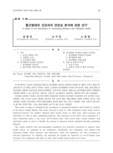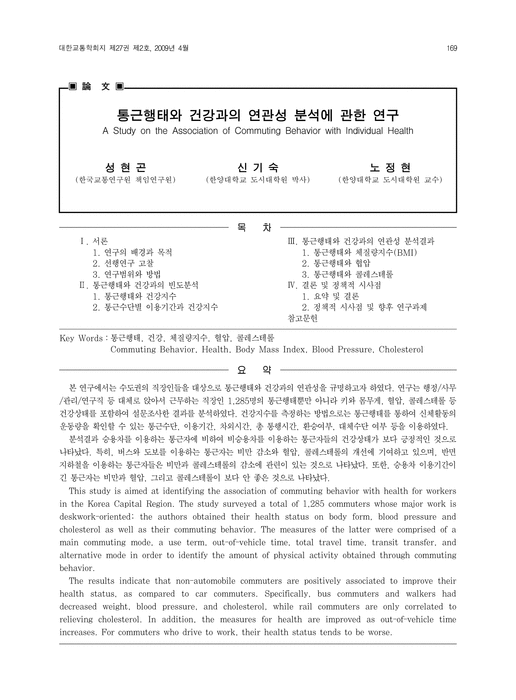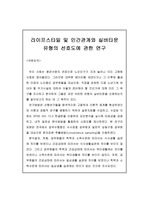

-
 * 본 문서는 배포용으로 복사 및 편집이 불가합니다.
* 본 문서는 배포용으로 복사 및 편집이 불가합니다.
미리보기
서지정보
· 발행기관 : 대한교통학회
· 수록지 정보 : 대한교통학회지 / 27권 / 2호
· 저자명 : 성현곤, 신기숙, 노정현
목차
Ⅰ. 서론
Ⅱ. 통근행태와 건강과의 빈도분석
Ⅲ. 통근행태와 건강과의 연관성 분석결과
Ⅳ. 결론 및 정책적 시사점
참고문헌초록
본 연구에서는 수도권의 직장인들을 대상으로 통근행태와 건강과의 연관성을 규명하고자 하였다. 연구는 행정/사무
/관리/연구직 등 대체로 앉아서 근무하는 직장인 1,285명의 통근행태뿐만 아니라 키와 몸무게, 혈압, 콜레스테롤 등
건강상태를 포함하여 설문조사한 결과를 분석하였다. 건강지수를 측정하는 방법으로는 통근행태를 통하여 신체활동의
운동량을 확인할 수 있는 통근수단, 이용기간, 차외시간, 총 통행시간, 환승여부, 대체수단 여부 등을 이용하였다.
분석결과 승용차를 이용하는 통근자에 비하여 비승용차를 이용하는 통근자들의 건강상태가 보다 긍정적인 것으로
나타났다. 특히, 버스와 도보를 이용하는 통근자는 비만 감소와 혈압, 콜레스테롤의 개선에 기여하고 있으며, 반면
지하철을 이용하는 통근자들은 비만과 콜레스테롤의 감소에 관련이 있는 것으로 나타났다. 또한, 승용차 이용기간이
긴 통근자는 비만과 혈압, 그리고 콜레스테롤이 보다 안 좋은 것으로 나타났다.영어초록
This study is aimed at identifying the association of commuting behavior with health for workers
in the Korea Capital Region. The study surveyed a total of 1,285 commuters whose major work is
deskwork-oriented; the authors obtained their health status on body form, blood pressure and
cholesterol as well as their commuting behavior. The measures of the latter were comprised of a
main commuting mode, a use term, out-of-vehicle time, total travel time, transit transfer, and
alternative mode in order to identify the amount of physical activity obtained through commuting
behavior.
The results indicate that non-automobile commuters are positively associated to improve their
health status, as compared to car commuters. Specifically, bus commuters and walkers had
decreased weight, blood pressure, and cholesterol, while rail commuters are only correlated to
relieving cholesterol. In addition, the measures for health are improved as out-of-vehicle time
increases. For commuters who drive to work, their health status tends to be worse.참고자료
· 없음태그
-
자료후기
-
자주묻는질문의 답변을 확인해 주세요

꼭 알아주세요
-
본 학술논문은 (주)학지사와 각 학회간에 저작권계약이 체결된 것으로 AgentSoft가 제공 하고 있습니다.
본 저작물을 불법적으로 이용시는 법적인 제재가 가해질 수 있습니다. -
해피캠퍼스는 구매자와 판매자 모두가 만족하는 서비스가 되도록 노력하고 있으며, 아래의 4가지 자료환불 조건을 꼭 확인해주시기 바랍니다.
파일오류 중복자료 저작권 없음 설명과 실제 내용 불일치 파일의 다운로드가 제대로 되지 않거나 파일형식에 맞는 프로그램으로 정상 작동하지 않는 경우 다른 자료와 70% 이상 내용이 일치하는 경우 (중복임을 확인할 수 있는 근거 필요함) 인터넷의 다른 사이트, 연구기관, 학교, 서적 등의 자료를 도용한 경우 자료의 설명과 실제 자료의 내용이 일치하지 않는 경우
“대한교통학회지”의 다른 논문도 확인해 보세요!
-
Positive Guidance 기법을 응용한 실시간 교통안전 경고정보 제공방안 11 페이지
최근 각종 센서 및 통신기술의 발달은 과거에 비해 보다 미시적이고 폭넓은 교통자료의 수집과 운전자의 주행편의를 위한 다양한 방식의 정보제공을 실시간 환경에서 가능하도록 하였다. 본 연구에서는 Positive Guidance 기법을 응용하 여 이와 같은 실시간 환경에서 적용 가능한 실시간 교통상충 분석 기반의 경고정보 제공 방안을 제안하고자 한다. 제안하.. -
신호교차로의 차량운행비용 특성을 고려한 경제성분석 모형개발 8 페이지
교통시설 투자평가에 대한 경제성 분석과 관련하여 일반적인 예비타당성조사 지침 및 투자평가지침에서 적용하는 차량운행 비용 절감편익 중 유류비 산정 자료는 차량운행시 유류소모량과 주행속도와의 관계만을 고려하여 분석하고 있다. 신호로 인한 정지지체가 발생하지 않는 연속류의 경우 주행속도와 통행시간의 변화로 인한 절감편익에 대한 고려가 가능하나, 실제 신호교.. -
고령보행자의 교통사고와 이동편의시설과의 관계 : 청주시를 사례로 9 페이지
이 연구의 목적은 청주시를 사례로 고령보행자의 교통사고와 이동편의시설과의 관계를 분석하는데 있다. 분석된 주요 연구결과는 다음과 같다. 첫째, 고령보행자의 사고는 가로구간에서, 그리고 횡단 중에 많이 발생하는 것으로 분석되었다. 둘째, 고령보행자 사고건수와 이동편의시설과의 상관분석 결과, 포장상태, 보행유도블록 및 점자블록 역시 고령보행자의 안전에 영.. -
대기행렬길이 제약조건을 고려한 Preemption 제어 전략에 관한 연구 9 페이지
현재 신호교차로에서 긴급 상황 시 신호교차로의 혼잡 상황으로 인해 긴급차량이 신호를 무시하거나 차선이탈, 역주행 등 타 이동류 및 보행자의 안전을 위협하는 상황이 발생하고 있다. 일반적인 Preemption 제어는 긴급차량 의 검지 즉시 Preemption 제어를 실시하고 있다. 이로 인해 긴급차량의 연속주행 확보는 가능하지만 일반차량의 지체는 증가하.. -
개인여객 효용의 극대화 및 운송특성공간상의 무차별곡선의 형태와 그 추정 12 페이지
개인여객이 운송수단을 선택하여 얻는 효용은 시간, 비용 등의 운송특성과 소득 등 개인특성의 함수이다. 기존 연구 에서는 일반적으로 운송특성이 여객효용에 미치는 효과를 추정하기 위한 방법으로 운송특성변수에 대해 선형인 효용함 수를 전제로 한 무작위 효용모형을 이용하여 왔다. 그러나 본 논문에서는 개인여객의 효용극대화를 분석하는 방법으로 서 운송수단선택행..
찾으시던 자료가 아닌가요?
지금 보는 자료와 연관되어 있어요!
문서 초안을 생성해주는 EasyAI






